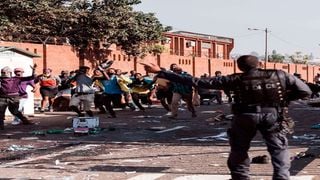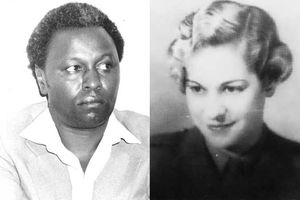
People flee from the Springfiled Park Mall in Durban on July 12, 2021.
News
Prime
Seven slain execution-style in Durban as vigilante violence increases
What you need to know:
- Police are investigating this mass killing, in which the seven victims were lined up, lying face down, and each shot once or more in the head.
- Local community members said the ‘vagrants’ had been part of a gang which had repeatedly victimised members of the KwaMashu settlement.
To live in South Africa means to deal with the constant threat of violent crime, something which has plagued low-income communities since even the apartheid era, when much policing in ‘no-go’ areas for the state authorities was left to affected communities by a largely uncaring government.
With violent crime has therefore come community ‘action’ to rid affected communities of unwanted elements suspected of crimes.
But in the nearly 30 years since the ending of the racist system of apartheid, community safety in many low-income, high-density settlements across the country has not improved much, if at all, with numerous incidents of community-based violence reported, usually in outbreaks of incidents which sweep through affected areas.
Most recently, South Africa has seen repeated incidents of violence and threats of violence against ‘foreigners’, non-South Africans living and working in the country whom populists have identified as being contributors to very low employment rates.
In some areas, increased housebreakings, muggings, rapes and murders have been blamed on ‘foreigners’ operating in illegal mining groups called ‘zama zamas (meaning, colloquially, ‘those who keep on trying’), with community groups targetting these people.
But with too few police for a burgeoning population, which is also increasingly urbanised in areas nearly impossible to police even in the daytime, the criminals, whether in gangs competing for drug sales or ‘zama zama crews’, the fight to bring ‘normal’ levels of criminality under control is not being won, despite repeated reassurances from government officials.
Highlighting the increasing tensions between organised criminals and the communities within which they live, and upon whom they primarily prey, there has been yet another mass murder event this week that has all the hallmarks of a community-based vigilante action.
The execution-style killing early this week of seven people – described as ‘vagrants’ but accused of being behind many crimes – who were living under a bridge near the high-density community of KwaMashu, north of Durban on South Africa’s Indian Ocean coastline, has again raised the spectre of community-based vigilantism.
Police are investigating this mass killing, in which the seven victims were lined up, lying face down, and each shot once or more in the head, 18 shell casings from a 9mm handgun being the primary physical evidence under investigation.
A police spokesman said authorities were working on the theory that the killings were part of a community action to rid themselves of criminal elements.
Local community members, who declined to be identified, said the ‘vagrants’ living under the freeway bridge, where their bodies had been found, had been part of a gang which had repeatedly victimised members of the KwaMashu settlement.
Far from a sense of shock over the killings, KwaMashu residents willing to speak to the media, though none wanting to be named, said that it had been “necessary to deal with our crime problem” as police were slow to react and had done nothing to move off the suspected criminals, despite many complaints.
Simphiwe Ntini, of the KwaMashu Community Police Forum, a body meant to interface with police to avoid outbreaks of violence from community members who feel they have no other options, told the media, “The community of KwaMashu is living in fear.”
That community members would so easily revert to and accept such violence is consistent with South Africa’s violent past – and poses worrying questions for the current administration of President Cyril Ramaphosa whose government has repeatedly promised to “deal with crime”, but which has made little overall progress to that end.
Murder and vicious assaults remain very common.
In another example from greater Durban this week illustrating the regularity of multi-murder incidents, police reported that five men in their 20s were found shot dead in a house in Inanda, about 20kms north-west of Durban, early Thursday (25/10). Investigators suspect inter-gang violence over drug dealing, another common cause of violence occurring almost daily.
In the immediate run-up to the 1994 democratic elections, inter-group violence became endemic in many parts of the country, with thousands of lives lost.
By the late 1990s decreasing political violence was replaced with increased ‘ordinary’ killings, pushing the country’s murder rate into the top of the global rankings.
Between the turn of the 2000s and about 2010, murder and violent crime rates dropped, but since then have climbed dramatically again.
According to police statistics, in the last quarter of 2022, some 83 people were murdered in South Africa every day, on average.
Having dropped slightly from highs of around 67 murders per 100,000 of the population in the late 1990s, it was statistically still true in 2001 that the average South African was more likely to be murdered than die in a car crash.
By 2009 that sky-high rate of citizen-on-citizen violence had fallen by half, from 67 per 100,000 in 1994 to around 34 murders per 100,000 people at the end of the first decade of the new millennium.
Behind the statistics are the millions living in fear of their lives daily, and of being mugged or raped or assaulted, at even higher levels of probability.
Historically, both during the ‘township rebellion’ of the mid-to late-1980s, during which many of the country’s shantytowns were far too dangerous for ordinary policing, and even for decades thereafter, the constant crime wave gripping poor communities has led to many community-based formations designed to bring some safety to their members.
But along with the criminals, innocents sometimes have also been targetted by angry mobs, as in the infamous case of Maki Skosana, a young woman murdered by a mob in the township of Duduza, near Pretoria, on July 20, 1985.
She was attending a funeral at Duduza when a crowd of mourners turned on her after some community members accused her of being an ‘impimpi’ (traitor or informer).
She was chased across a field, brutally beaten, stoned, and her clothes torn off.
A large huge rock was placed on her so that she could not escape and, in front of the cameras of a large international audience, a broken bottle was forced into her vagina before she was finally killed by the notorious ‘necklace’ method – a used car tyre stuffed with petrol-soaked rages forced over her upper torso and set alight.
Her horrible death was used by the apartheid regime as a propagandistic demonstration of the supposed barbarism of township residents.
But Skosana was not an informer – the accusation, amid the high emotions of that time, quickly led to her murder, as was the case in some other incidents.
Similar cases have also been recorded since, some to do with the growing anti-foreigner sentiment which has become known under the name of ‘Operation Dudula’ since early 2022, when violence by its members against foreigners broke out in Soweto, near Johannesburg.
Between the events of the apartheid years and more recent anti-foreigner violence, there have been repeated instances of community-led deadly vigilantism.
One such, illustrating numerous others, occurred in 2011 when, after “one crime too many”, residents of New Brighton, a low-income township in the Eastern Cape province near the Nelson Mandela Bay Metro, took matters into their own hands.
Two men reportedly broke into the home of an elderly woman, stole her television, and then stabbed her tenant to death as he tried to protect her.
The next day, neighbours tracked down the thieves, put tyres around their necks, doused them with petrol and set them ablaze – the infamous ‘necklace’ was back.
“These boys had been causing problems in the community for a long time. They terrorised us,” said a New Brighton resident.
“People were shouting, emotions were high. Everything happened all at once,” he told the local news media, speaking on condition of anonymity to avoid arrest.
Once a punishment meted out to perceived sell-outs in the fight against white-racist rule, or sometimes to common criminals convicted by “people's courts”, that necklacing incident was not a stand-alone.
In just two weeks around the time of those killings, at least six other similar incidents were reported in the greater Port Elizabeth area, said police spokesperson Dumile Gwavu, all ascribed to community-based frustrations and anger over rampant criminality boiling over.
Back in KwaMashu, where this week’s mass murder event took place, the Community Policing Forum said that there were still many criminals plaguing the community, and that people did not necessarily feel any safer for the deaths of the suspects who had been murdered this week.
KwaMashu has seen several shootings in recent months, like many other low-income areas, as South Africa’s poor economy and deepening impoverishment have pushed a greater number into criminality, and their communities into violent responses.
That the situation is severe and worsening was underlined by the fact that the multiple murders of the suspected criminals this week took place close to the KwaMashu police station, despite which, there had been no immediate reaction from police to the gunfire involved.
Beyond the contention between communities and the criminals who live in them, South Africa also endures ongoing low-level political violence, which together with other forms of endemic violence recently drew Police Minister Bheki Cele to the Zulu homeland province, there to help bring the killings under control, ahead of an election in around six months.
Cele said that political violence alone had claimed 155 lives in KwaZulu-Natal in the past 12 years, and that several political parties had had members slain.
Of 103 municipal office bearers and officials in political offices who had been murdered, said the minister, 52 were elected councillors, 31 from the ruling African National Congress (ANC), 14 from the rival traditionalist Inkatha Freedom Party, while IFP-breakaway entity the National Freedom Party had lost four of its councillors, with Julius Malema’s Economic Freedom Fighters losing two and the African Christian Democratic Party having lost one.
Cele has repeatedly said KwaZulu-Natal in particular, along with other high-tension areas of the country, mainly in greater Johannesburg and some parts of Cape Town, were experiencing unacceptably high violent crime and murder rates that were again on the increase.
Political analysts point to the worrying implications for the forthcoming ‘political season’, during which increased political violence was considered likely to add to an already-high murder rate that puts South Africa on a par with some war zones around the world.




